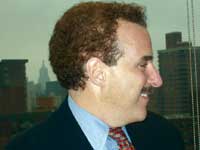




International
Perspectives on Autism Presented at NYU Child Study Center
by Pola Rosen,
Ed.D.
At a recent all-day conference focusing on state
of the art developments in autism organized under the aegis
of Dr. Harold Koplewicz, Professor of Child and Adolescent
Psychiatry at the NYU School of Medicine, Director of the NYU
Child Study Center and Vice-Chairman, Department of Psychiatry,
evidence was offered on mitochondrial disorders, specifically
the identification of three genes associated with autism. According
to the findings of Dr. Joseph Buxbaum from Mt. Sinai Medical
Center, while idiopathic autism is likely genetic and the genes
are very difficult to identify, the good news is that there
are effective treatments available; the earlier and more intensive,
the better.
Sir Michael
Rutter from The Institute of Psychiatry in London, respondent
to the brilliant array of presenters from around the country
stated that “autism is probably
multi-factorial which means there must be nongenetic factors.
We know nothing about environmental factors; they may play
a role as well. The evidence suggests that there may be some
synergistic effect.”
Dr. F. Xavier Castellanos, moderator of the conference
underscored the fact that parents and advocates started the
scientific rigor that we see today. Currently, there are about
400 families in a data base that is being shared nationwide:
the url is agre.org. While elements of the disorder have been
around for a long time (e,g. dyslexia and language disorder),
some researchers think that gene strategies will be the approach
of the future.
Dr. Catherine Lord from the University of Michigan,
discussed her longitudinal study of children starting at age
two. Ongoing for nine years, the numbers of children in one
study are 102 and in another, 68. Tests that she used to look
at autism were ADOS and PL-ADOS. The two main criteria in diagnosing
autism are repetitive behavior and lack of social communication.
Lord's findings interestingly include a presence of complex
language at age nine, in 40 percent of the population studied.
Lord ended
by discussing the pattern of word loss accompanied by the
loss of social skills. Questions still to be answered are
why some children with autistic spectrum disorder (ASD) have
greater social-communication skills than others prior to
age two and then lose them. Lord postulated that the “loss
of words could be a specific marker for ASD.”
An important
question posed by Dr. Koplewicz was “How
do we teach school systems to evaluate these children in order
to ensure that they get services?”
The consensus of opinion was the importance of
a multi-disciplinary, multi-field assessment. A ten hour evaluation
is unrealistic but so is a one hour session. The importance
of having evaluators experienced in working with two-year-olds
was underscored.#
